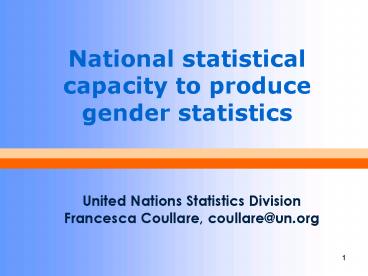National statistical capacity to produce gender statistics - PowerPoint PPT Presentation
1 / 12
Title:
National statistical capacity to produce gender statistics
Description:
Co-operating Agencies: In collaboration with the Gender Group and Data Group of ... Hosted by ISTAT and co-organized and co-sponsored by UNSD, ISTAT, UNFPA ... – PowerPoint PPT presentation
Number of Views:58
Avg rating:3.0/5.0
Title: National statistical capacity to produce gender statistics
1
National statistical capacity to produce gender
statistics
- United Nations Statistics Division
- Francesca Coullare, coullare_at_un.org
2
Overview
- National statistical capacity to produce
statistics by sex assessed through 2 lenses - Countries capacity to monitor Goal 3 in the MDGs
- Country regular reporting of sex-disaggregated
data to UNSD (recently presented in The World's
Women 2005 Progress in Statistics) - UNSD programme to strengthen gender statistics in
developing countries
3
Countries capacity to monitor MDG 3
- The Millennium Development Goals Indicators
Website/Database - mdgs.un.org
4
Countries capacity to monitor MDG 3
MDG 3 Promote gender equality and empower women
MDGs global monitoring under the responsibility
of the Inter-Agency and Expert Group on MDGs
Indicators (IAEG), coordinated by
UNSD. -sub-group on gender to address the
following major concerns -identify better
indicators for women participation in
economy -include additional gender
dimensions/concerns (mainly violence against
women and reproductive health)
5
Countries capacity to monitor MDG 3
Data availability for the global/regional
monitoring
Percentage of countries with at least 2 data
points since 1990 (excluding modeled data), by
indicator and MDG region
6
Proposed revised indicator 11
- 1. Share in total employment
- 2. Agricultural employment
- 2.1 Own account workers, employers
- 2.2 Contributing family workers (informal)
- 2.3 Employees (formal and informal)
- 3. Non-agricultural employment
- 3.1 Own account workers, employers (formal and
informal) - 3.2 Contributing family workers (informal)
- 3.3 Employees (excl. domestic employees) (formal
and informal) - 3.4 Domestic employees (formal and informal)
- (all disaggregated by sex)
Only work in progress. not included in MDG
indicators framework because of lack of data!
7
Countries capacity to produce sex-disaggregated
data
- Extracts from
- The World's Women 2005
- Progress in Statistics
8
Countries capacity to produce sex-disaggregated
data
The World's Women 2005 Progress in Statistics
- Focuses on national reporting of sex
disaggregated statistics on - demographics,
- health,
- education,
- work,
- violence against women,
- poverty,
- human rights and decision-making.
9
ex. (a) Women and the labour forceTheir
Contribution Still Not Fully Captured By Official
Statistics
- Earning power
- Closing the gap between womens and mens pay
continues to be a major challenge in most parts
of the world. - Less than 25 of countries reported data on wages
by major industry groups disagreggated by sex.
10
ex. (b) Bringing Violence Against Women to
Public ScrutinyVery limited data available
- Since the adoption of the Beijing Platform for
Action in 1995, major improvements in developing
methodologies and procedures for collecting data
on violence against women - But still there is currently only scarce official
international data collection on this issue. - WHOs Multi-Country Study on Womens Health and
Domestic Violence - UNICEF - MICS
11
UN Global Programme on Gender Statistics
- Duration 3 years (2007-2009)
- Location/Executing agency United Nations
Statistics Division, New York - Co-operating Agencies In collaboration with the
Gender Group and Data Group of the World Bank,
United Nations Population Fund (UNFPA) United
Nations Development Programme (UNDP) - National Counterpart Institutions National
Statistical Offices and gender statistics focal
points - Collaborating Regional Institutions United
Nations regional commissions (ECA, ECE, ECLAC,
ESCAP, and ESCWA) and other regional
organizations (such as CARICOM, ECOWAS, SPC)
12
UN Global Programme on Gender Statistics
- Objective to enhance the capacity of countries
to collect, analyse and disseminate quality
gender statistics - Achieved through
- Inter-agency expert group
- web-based Bulletin Board (portal)
- database
- training materials and workshops
- training of trainers
- ad-hoc technical advisory services
- network of resource persons
Official Launch 2007 Global Forum on Gender
Statistics Rome, 10-13 December 2007 Hosted by
ISTAT and co-organized and co-sponsored by UNSD,
ISTAT, UNFPA































